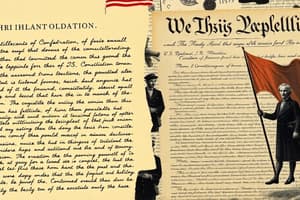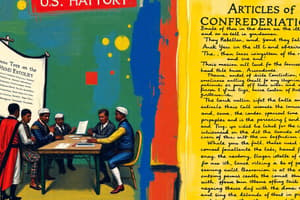Podcast
Questions and Answers
Match the following terms with their definitions:
Match the following terms with their definitions:
Anti-Federalist = An opponent of the Constitution favoring strong state governments Ratify = To formally approve or confirm Amend = To change or add to a document Separation of Powers = A system that divides government power among three branches
Match the following branches of government with their responsibilities:
Match the following branches of government with their responsibilities:
Executive = Responsible for enforcing laws Legislature = The branch that makes laws Judicial = Interprets laws and ensures they are constitutional Checks and Balances = Prevents any one branch from dominating
Match the following government bodies with their characteristics:
Match the following government bodies with their characteristics:
Senate = Two senators from each state House of Representatives = Representation based on population Congress = The legislative branch of the U.S. government Supreme Court = The highest court in the United States
Match the following individuals with their roles:
Match the following individuals with their roles:
Match the following concepts with their meanings:
Match the following concepts with their meanings:
Match the following pairs of terms with their descriptions:
Match the following pairs of terms with their descriptions:
Match the following terms with their related concepts:
Match the following terms with their related concepts:
Match the following amendments-related actions with their definitions:
Match the following amendments-related actions with their definitions:
Match the following events with their descriptions:
Match the following events with their descriptions:
Match the following plans with their characteristics:
Match the following plans with their characteristics:
Match the following individuals with their roles:
Match the following individuals with their roles:
Match the following terms with their definitions:
Match the following terms with their definitions:
Match the following historical documents with their significance:
Match the following historical documents with their significance:
Match the following compromises with their outcomes:
Match the following compromises with their outcomes:
Match the following historical figures with their associated plans or principles:
Match the following historical figures with their associated plans or principles:
Match the following historical events with their impacts:
Match the following historical events with their impacts:
Flashcards are hidden until you start studying
Study Notes
Shays’ Rebellion and Articles of Confederation
- Armed uprising occurring from 1786 to 1787 in Massachusetts, led by Daniel Shays and farmers.
- Protests centered on economic struggles, excessive taxation, and government debt.
- The rebellion exposed significant weaknesses in the Articles of Confederation, highlighting the need for a stronger central government.
Constitutional Convention and Compromise Proposals
- Convened in Philadelphia in 1787 to address the inadequacies of the Articles of Confederation.
- New Jersey Plan advocated for equal state representation, beneficial for smaller states.
- Virginia Plan proposed representation based on state population, favoring larger states.
- The Great Compromise established a bicameral legislature: equal representation in the Senate and proportional representation in the House of Representatives.
- The 3/5 Compromise determined that enslaved individuals would count as three-fifths of a person for taxation and representation.
Foundational Figures
- George Washington served as the first President and presided over the Constitutional Convention.
- James Madison, known as the "Father of the Constitution," was pivotal in drafting both the Constitution and the Bill of Rights.
- Roger Sherman played a crucial role in the Great Compromise, impacting the structure of Congress.
- William Paterson proposed the New Jersey Plan, advocating for equal representation in Congress.
- George Mason, an Anti-Federalist, opposed the Constitution's ratification without a Bill of Rights.
Federalists vs. Anti-Federalists
- Federalists, including figures like Alexander Hamilton, James Madison, and John Jay, supported a strong central government and the Constitution.
- Anti-Federalists favored state power, expressing concerns over a potentially overpowering central government, insisting on the inclusion of a Bill of Rights.
Structure of Government
- Congress is the legislative branch, consisting of the Senate (equal representation) and House of Representatives (population-based representation).
- The President leads the executive branch, tasked with enforcing laws and acting as commander-in-chief.
- The Supreme Court is the judiciary's highest authority, interpreting laws and ensuring constitutional compliance.
- The separation of powers divides government functions among the executive, legislative, and judicial branches to prevent concentration of power.
- Checks and balances ensure that each branch can regulate the others, maintaining a balance of power.
Constitution and Amendments
- The Constitution serves as the foundational legal document outlining the government’s structure and citizens' rights.
- Ratification is the formal approval process for the Constitution or its amendments.
- Amendments modify the Constitution to adapt to changing societal needs.
- The U.S. Congress is described as bicameral, comprising two legislative chambers, the Senate and the House of Representatives.
Studying That Suits You
Use AI to generate personalized quizzes and flashcards to suit your learning preferences.




